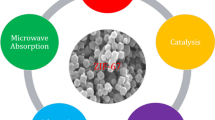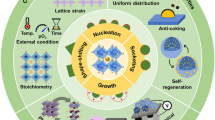Abstract
Nanocrystalline lithium zirconate (Li2ZrO3) was successfully prepared by an epoxide-mediated sol–gel process. The compositions and morphologies of Li2ZrO3 were characterized by X-ray diffraction, scanning electron microscopy and transmission electron microscopy, and the CO2 capture-regeneration properties of Li2ZrO3 were investigated by thermogravimetric analysis. The introduction of propylene oxide as an acid scavenger increases the pH value of the system to mediate the sol–gel transition. The as-dried xerogel is amorphous and the nano-sized Li2ZrO3 crystallites with a tetragonal phase precipitate after heat-treatment at 650 °C. The nanocrystalline tetragonal-Li2ZrO3 exhibits a better CO2 capture properties, possessing an adsorption capacity as high as 21 wt.% at 550 °C and a good stability confirmed by CO2 capture-regeneration cycles.
Graphical Abstract
Nanocrystalline Li2ZrO3 possessing good CO2 capture properties was successfully prepared by an epoxide-mediated sol–gel process.






Similar content being viewed by others
References
Duan Y (2011) Electronic structural and electrochemical properties of lithium zirconates and their capabilities of CO2 capture: A first-principles density-functional theory and phonon dynamics approach. J Renew Sustain Energy 3(1):1–17
Pannocchia G, Puccini M, Seggiani M, Vitolo S (2007) Experimental and modeling studies on high-temperature capture of CO2 using lithium zirconate based sorbents. Ind Eng Chem Res 46(21):6696–6706
Nakagawa K, Ohashi T, Nakagawa K, Ohashi T (1997) A novel method of CO2 capture from high temperature gases. J Electrochem Soc 145(4):1344–1346
Nakagawa K, Ohashi T (1999) A reversible change between lithium zirconate and zirconia in molten carbonate. Electrochemistry 67:618–621
And JI, Lin YS (2003) Mechanism of high-temperature CO2 sorption on lithium zirconate. Environ Sci Technol 37(9):1999–2004
Yamauchi K, Murayama N, Shibata J (2007) Absorption and release of carbon dioxide with various metal oxides and hydroxides. Mate T 48(10):2739–2742
Wang S, An C, Zhang QH (2013) Syntheses and structures of lithium zirconates for high-temperature CO2 absorption. J Mater Chem A 1(11):3540–3550
Ochoa-Fernández E, Rønning M, Grande T, Chen D (2006) Synthesis and CO2 capture properties of nanocrystalline lithium zirconate. Chem Mater 18(25):6037–6046
Subha PV, Nair BN, Hareesh P (2014) Enhanced CO2 absorption kinetics in lithium silicate platelets synthesized by a sol–gel approach. J Mater Chem A 2(32):12792–12798
Nair BN, Yamaguchi T, Kawamura H, Nakao SI, Nakagawa K (2008) Processing of lithium zirconate for applications in carbon dioxide separation: structure and properties of the powders. J Am Ceram Soc 87(1):68–74
Eriksen KBYDØ (2006) Low temperature liquid state synthesis of lithium zirconate and its characteristics as a CO2 sorbent. Separ Sci Technol 41(2):283–296
Ochao-Fernandez E, Roenning M, Grande T (2006) Nanocrystalline lithium zirconate with improved kinetics for high-temperature CO2 capture. Chem Mater 18(6):1383–1385
Ida J, Xiong R, Lin YS (2004) Synthesis and CO2 sorption properties of pure and modified lithium zirconate. Sep Purif Technol 36(1):41–51
Choy JH, Han YS (1997) Citrate route to the piezoelectric Pb (Zr, Ti) O3 oxide. J Mater Chem 7(9):1815–1820
Gash AE, Tillotson TM, Satcher JH (2001) Use of epoxides in the sol-gel synthesis of porous iron (III) oxide monoliths from Fe (III) salts. Chem Mater 13(3):999–1007
Tokudome Y, Fujita K, Nakanishi K (2007) Synthesis of monolithic Al2O3 with well-defined macropores and mesostructured skeletons via the sol-gel process accompanied by phase separation. Chem Mater 19(14):3393–3398
Quang DV, Sarawade PB, Hilonga A (2011) Preparation of silver nanoparticle containing silica micro beads and investigation of their antibacterial activity. Appl Surf Sci 257(15):6963–6970
Acknowledgments
This work is supported by the National Natural Science Foundation of China (51372225).
Author information
Authors and Affiliations
Corresponding author
Ethics declarations
Conflict of interest
The authors declare that they have no competing interests.
Rights and permissions
About this article
Cite this article
Guo, X., Ding, L., Ren, J. et al. Preparation and CO2 capture properties of nanocrystalline Li2ZrO3 via an epoxide-mediated sol–gel process. J Sol-Gel Sci Technol 81, 844–849 (2017). https://doi.org/10.1007/s10971-016-4233-7
Received:
Accepted:
Published:
Issue Date:
DOI: https://doi.org/10.1007/s10971-016-4233-7




